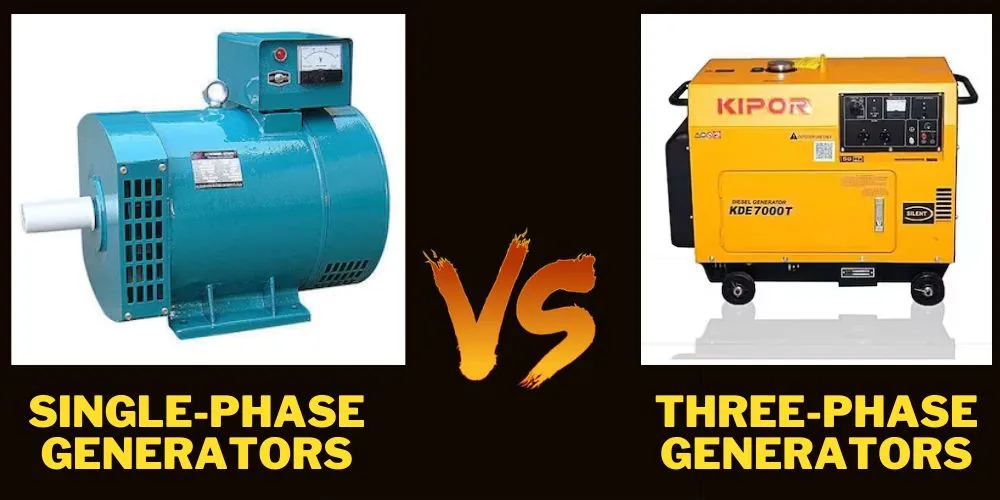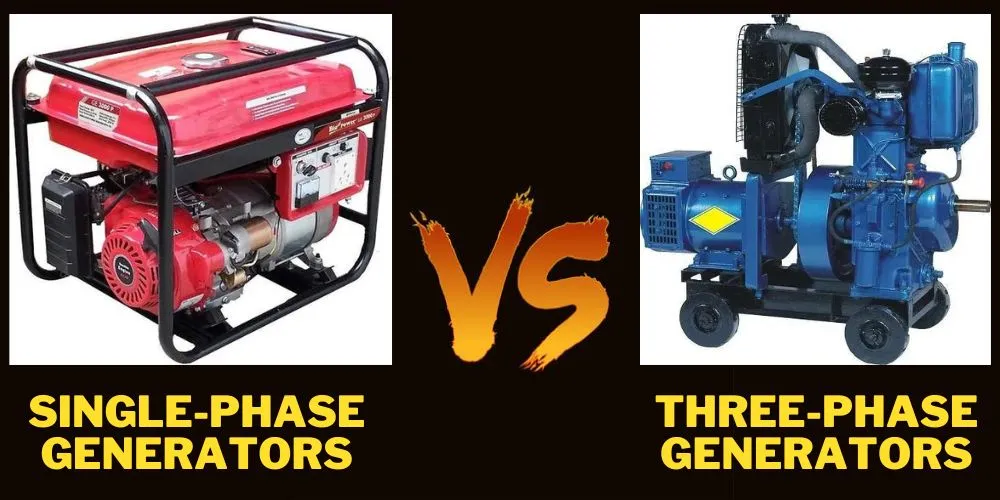Electricity is the cornerstone of modern civilization, powering our homes, businesses, and industry. Generators come to the fore when a constant electrical supply is critical, and there is a need to ensure redundancy or provide off-grid power.
But when it comes to choosing a generator, we are faced with a major decision: whether to go with a single-phase or a three-phase generator.
Both have their unique characteristics, advantages, and applications. Let’s explore the intricate details that differentiate single phase vs three phase generators.

Understanding Single-phase Generators
A single-phase generator is a common choice where the electrical load is light, primarily in residential settings or small businesses. It produces power by creating a single alternating current (AC), offering simplicity both in terms of design and operation.
Definition and Functionality
In essence, a single-phase generator delivers power through a single, fluctuating voltage. The electricity it produces waxes and wanes in unison, peaking at certain points in its cycle.
This simple alternation of current makes the single-phase generator a go-to option for everyday appliances and lighting that don’t require hefty power draws.
Advantages and Disadvantages
Single-phase generators are celebrated for their simplicity. They are typically less expensive to purchase and install compared to their three-phase counterparts.
Their operation is straightforward, which often translates to lower maintenance costs and ease of repair. Smaller in size, they serve well where space is a constraint.
However, on the flip side, single-phase generators have their limitations. They are not ideally suited for running heavy machinery or loads that require a constant, high-power supply, as the output is less uniform, and the overall power delivery is limited.
Common Applications
For residential use or in small workshops, where the consumption of electricity is relatively moderate, single-phase generators are perfectly suited.
They are optimal for powering lights, TVs, refrigerators, and small power tools – simpler applications where the demand on the generator is predictable and not excessively high.
You may also find useful: Diesel Generators Vs UPS Systems | Portable vs Standby Generators
Understanding Three-phase Generators
When the demand for power is high, and the load is more consistent and industrial in nature, a three-phase generator is often the best choice. With three overlapping currents, these powerhouses are tailored to meet the needs of heavy-duty operations.
Definition and Functionality
Three-phase generators operate on a principle that involves delivering electricity through three alternating currents that are out of phase with one another by 120 degrees.
This phasing difference means that there is always a net output, resulting in a constant delivery of power, which is smoother and more reliable for heavy-duty and large-scale operations.
Advantages and Disadvantages
The primary advantage of a three-phase generator is its power output capacity. It can power up hefty machinery and equipment that a single-phase generator simply cannot handle.
Also contributing to a three-phase generator’s appeal is its efficiency, especially in industrial settings where power usage is quite substantial.
Higher efficiency equals less power wastage and can result in lower energy costs over time. The drawbacks might include a higher upfront cost, more complex installation requirements, and the need for greater space.
Common Applications
Three-phase generators are practical in environments that require a stable and continuous power flow, such as manufacturing plants, commercial complexes, and large-scale agricultural facilities.
These generators keep industrial motors running smoothly and support systems that are power-dependent, ensuring that there are no interruptions to critical operations.
Single Phase Vs Three phase Generators
The core distinctions between single-phase and three-phase generators can be found in their power output, efficiency, physical attributes, and cost considerations.

Power Output and Efficiency
In terms of power output, three-phase generators are clear winners. They deliver a more stable and consistent form of energy, which is essential for companies that depend on machinery that needs to run without hiccups or variations in power.
Additionally, in terms of efficiency, three-phase electricity is less prone to loss of energy, making it the more economical option in the long run for extensive power usage.
Voltage and Current Characteristics
The voltage and current characteristics of single-phase and three-phase systems also differ significantly. Single-phase electricity is more susceptible to dips and peaks since its current follows a sinusoidal waveform.
In contrast, the current in a three-phase system provides a more balanced load, eliminating the issues of flickering lights or variations that can damage sensitive equipment.
Cost and Size Considerations
Cost and size are essential factors when choosing between these two options. Single-phase generators are smaller and cheaper but best suited for light loads.
On the other hand, Three-phase generators are costlier and larger but crucial for industrial-grade energy demands. They command a higher price not just in terms of units but also installation and maintenance.
Pro Tips for Choosing
Choosing between a single-phase and a three-phase generator should be guided by the intended use and the load demand of the equipment you need to power. For small setups and household needs, single-phase generators are sufficient and economical.
If your operations are larger and involve heavy-duty machinery, you will benefit from the robust and continuous power supply provided by three-phase generators.
Safety Considerations
Operating Safety:
- Ensure proper grounding of the generator to prevent electrical shock.
- Keep the generator dry and do not use it in wet conditions to avoid electrocution.
- Maintain adequate ventilation to reduce the risk of carbon monoxide poisoning from exhaust gases.
- Regularly inspect for damaged parts, and promptly repair to maintain safe operation.
- Wear appropriate protective gear when operating or performing maintenance.
Emergency Protocols:
- Install emergency shut-off switches accessible in case of an emergency to quickly cut power.
- Train all operators on emergency stop procedures and first-aid responses for potential injuries.
- Establish clear labeling and signage for quick identification of shut-off points and safety equipment.
- Conduct periodic emergency drills to ensure preparedness and proper response to an actual event.
- Keep fire extinguishers and first-aid kits readily available near the generator site.
Conclusion:
Generators are vital components in maintaining continuous and dependable power supplies. Single-phase and three-phase generators each have their place in different settings.
For the home user or small business owner, a single-phase generator could be the perfect fit. But for larger commercial or industrial operations, the three-phase generator stands out as the best candidate due to its consistent high power output and efficiency.
Understanding your needs and the capability of each generator type is crucial in making the right choice that ensures power reliability and economic operation.
